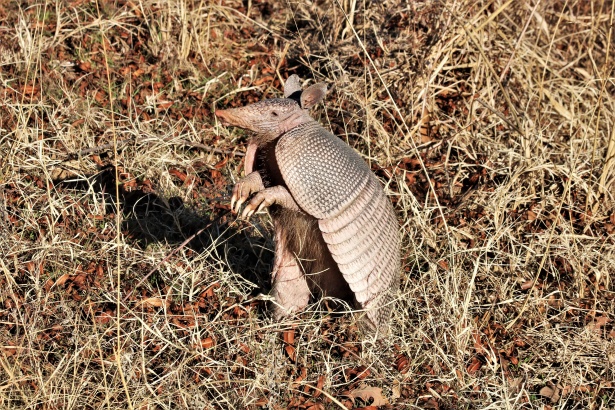Armadillo Removal and Control
281-667-0171

Armadillo Facts
Armadillos are barrel-shaped animals covered with natural armor. In fact, its name in Spanish means “little armored one.” The armadillo’s armor works well against most predators, but not against cars. They are also known as the “Hillbilly Speed Bump” for their tendency to get run over by vehicles.
Size & Description
There are 21 species of armadillo, according to the Integrated Taxonomic Information System (ITIS). Some armadillos are very small, while others are huge. The smallest is the pink fairy armadillo, which is about 6 inches (15 centimeters) long. Giant armadillos are the largest species, and are about 5 feet (1.5 meters) long, according to National Geographic. An armadillo’s armor is made up of overlapping plates covering the back, head, legs and tail. The number of armored bands identifies the different species, according to the San Diego Zoo. Only one species, the three-banded armadillo, can roll itself into a hard armored ball to defend itself against predators. Other armadillo species simply dig a hole quickly and hunker down so that their tender stomach is protected and their armor is the only thing visible.
Armadillos have pointy snouts and long, sticky tongues, similar to anteaters, which are close cousins. Their eyesight is poor, so they hunt with a highly developed sense of smell. They also have wiry hairs along their sides and belly, which they use to feel their way around, like curb feelers on some cars. They also have strong legs and sharp claws for digging.
Habitat
Most armadillos stick to areas closer to the equator because they like temperate to warm areas due to their lack of fat stores. According to the Internet Center for Wildlife Damage Management, armadillos are very picky about where they live based on what type of soil is found in the area. Usually, armadillos prefer sandy or loam soils that are loose and porous. This makes digging for food and creating burrows easier.
All armadillos live in Central and South America, except for one species. The nine-banded armadillo ranges from Argentina to the southern United States, according to the Animal Diversity Web (ADW) at the University of Michigan. Since the mid-19th century, nine-banded armadillos have expanded northward. They have been seen in Florida and are now common in Missouri. In 2000, the body of a nine-banded armadillo was found in central Illinois, according to ADW.
Habits
Armadillos are not social creatures and spend most of their time sleeping. They usually sleep up to 16 hours each day in burrows, according to National Geographic. During the morning and evenings, they forage for food.
Usually, the only time armadillos get together is to mate or to keep warm. During cold times, a group of armadillos may hunker down in a burrow together to share body heat. Sometimes, a seven-banded armadillo will share its burrow with others of the same gender, though.
Diet
Armadillos are omnivores, which means they eat meat and plants, though 90 percent of an armadillo’s diet is made up of insects and larvae, according to the Internet Center for Wildlife Damage Management. With their long, sticky tongue, armadillos catch ants, beetles, termites and other insects after digging them out of the ground. They also eat plants, eggs, small vertebrates and some fruit. From time to time, they will scavenge for dead animals. Source
The Critter Team specializes in armadillo removal and trapping. In our area we have the nine-banded armadillo, and are normally about the length of a cat. A armadillo is a prolific digger, they dig multiple burrows for homes and also for food. They eat invertabrates and insects. These burrows are often used by other animals once abandoned by the armadillo. The armadillo original habitat is in wood, brush, scrubs and grasslands. They have evolved into living in our community. They now dig under deck, patio, and even under the foundation of your home.
Are you noticing your freshly manicured mulch bed dug up? Are there large holes appearing in your yard. There is a very large chance that this could be from Armadillos. Armadillo Removal is very important to our clients. The yards that are usually the most effected are the ones with fresh mulch and also yards that are water regularly. This softens the yard which is exactly what is desired by them.

The Critter Team wildlife control experts will save your yard, house foundation from all the armadillo digging. We offer a large array of services to get armadillo out and keep them out. If they are digging under patio or decks we will install a dig barrier to stop them from reentering in the future. Armadillos are very strong and if the incorrect materials are used they will just bust their way thru. All of our technicians are highly trained in armadillo trapping and removal. We will give you multiple effective options to solve the issue. If you have any questions or need our armadillo removal services give us a call 281-667-0171
